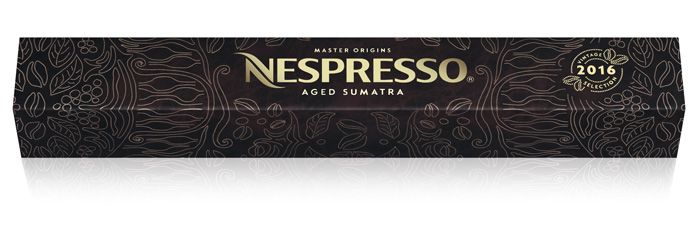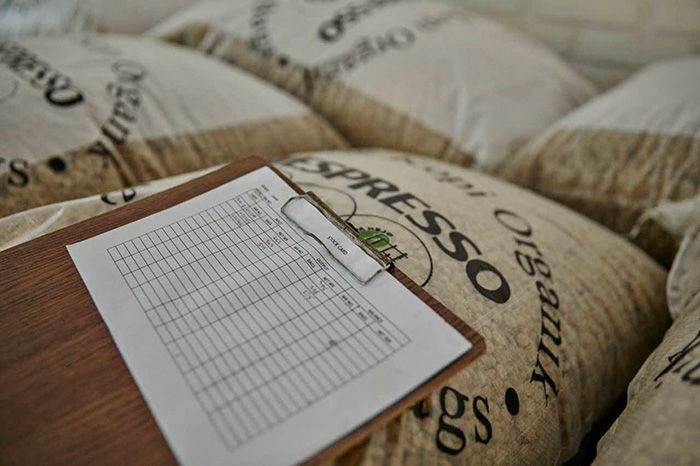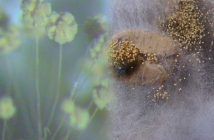Launched last August by Nespresso, the controversial coffee, which is part of a special edition, and which will only be available until the end of October, has blown the minds of market professionals, dividing opinions between those who thought it was pure marketing and advocates of new experiences.
For those who did not follow the discussions, Origen Aged Sumatra, according to Nespresso, was made from the manual harvest of 100% Arabica beans, harvested in 2016 where the coffee went through a three-year maturation process until it reached the consumer’s cup. Stored in permeable jute bags, the grains went through a slow process of loss and gain of moisture, following the rhythm of nature. Every three months, these bags were opened so that the grains were exposed to the air and dried evenly. The result, according to the company, is a coffee rich in woody notes and that highlights flavors such as cocoa and caramel.

Credit: assessoria Nespresso
And that is when the controversy started: is Origen Aged Sumatra an aged or old coffee? One of the first to take a stand on the subject was the barista and entrepreneur Léo Moço, who even published on August 21, in his instagram account, @barista.leomoco, a video explaining why he thought it was just a marketing ploy. “The coffee seed is a living being and, since the harvest is made, that living being has a life span. And if this period is well taken care of, in optimum conditions, outside the jute bags, temperature of 10 degrees, in parchment or in coconuts, we did manage to guarantee this life, extend it for a year, maybe a year and a half. However, this process you do with aging, is nothing more than leaving the coffee old and dead. This is chemical. This is not technology; it is not a detail about turning coffee every three months for three years. This is a natural and irreversible process that happens with the seed. This is scientific knowledge of those who work with seeds. I would like to make this video to alert you, consumer, that this is nothing more than a marketing game from a company that could be doing a great job, perhaps in relation to a new flavor of an old coffee,” he concluded.

Credit: assessoria Nespresso
The roast master Ensei Neto, on the other hand, shared his opinion on his instagram account, @enseineto: “This coffee was produced according to a classic process widely practiced in Indonesia, whose predominant climate in the summer is muggy and hot, known as Monsoon and, therefore, the coffees in that region are called monsoonian. As in Brazil, freshly picked coffees go to warehouses in a particularly critical period, which is summer, always rainy and hot. This perverse combination increases the stress of stored grains, greatly reducing their shelf life. Yes, the seeds of the coffee fruits are dried by the producers up to 10.5% and 11.5% m/m in order to be kept alive until the time of roasting. Therefore, the certainty is that the seeds die, like every living thing. The death of the seed leads to the loss of the volatiles that are in the interstices, emphasizing the taste of cellulose or wood. But in Brazil, having aged coffee was a common practice among farms in the south of Minas and Mogiana, which were (and still are) sold as rested by well-known producers. Therefore, this novelty is not so new. So relax and enjoy it. Experimenting is always good, especially without prejudice or blindly,” he clarified.

Credit: assessoria Nespresso
To add even more fuel to this fire, we went on to talk, exclusively, with the researcher from the Agronomic Institute (IAC), Gerson Giomo, who only agreed to give his opinion in writing. The IAC is an agency directly linked to the Department of Agriculture and Supply in the State of São Paulo.
Giomo is an agronomist from the Universidade Estadual Paulista (1993), a master’s degree (1999) and a PhD in Agronomy from the Universidade Estadual Paulista (2003) and a post-doctorate in Agricultural Engineering-Processing of Agricultural Products from the Federal University of Lavras (2009). Scientific researcher at Instituto Agronômico (IAC), he works in the areas of Post-Harvest, Coffee Production Systems, Processing Technology and Quality Control of Coffee, with emphasis on sensory quality. He is an international taster of specialty coffees for the Specialty Coffee Association (SCA) and QGrader certified by the Coffee Quality Institute (CQI).
See below what the Academy thinks about the subject:
COLD COFFEE / AGED COFFEE
Grão Especial – What is an old coffee?
Gerson Giomo – In general, it can be said that old coffee is any coffee that is not of a current crop, which has aged naturally during a certain period of storage of the beans. Thus, a coffee stored in a conventional way in jute sacks and in a non-air-conditioned environment is already considered to be old from 12 months after the harvest, being also referred to as “coffee of the remaining harvest”.
Grão Especial – What is the difference between an old coffee and an aged coffee?
Gerson Giomo – The old coffee is the one that has undergone a natural aging process due to the storage time, that is, an aging by the age of the stored grain.
An aged coffee is a coffee that has undergone some artificial aging process, under controlled conditions for a certain period of time. In this aging process, physical and chemical changes occur in the beans, thus providing a differentiated sensory profile without causing the drink to necessarily show off a characteristic aroma and flavor of old coffee. An example of this process is the “monsoon coffee”, produced in Malabar/Indonesia, where the coffee is aged for 3 to 4 months under conditions of high relative humidity. It is important to note that this aging process applies to new, freshly harvested coffees, that is, current crops.
Therefore, if the aged coffee is from the remaining vintage, it will be considered old coffee as well, as it will present a loss of quality in the same way as coffee that has aged naturally over the storage period, differing only in the intensity of perception of some characteristic aromas and flavors. old coffee.
Grão Especial – The coffee seed is a living being. From the moment of harvest, it has a life span. If it is properly handled in optimal conditions, how long will it last? Experts I’ve heard say that the one can extend it for no longer than one year, one year and a half at most. Do you agree with this opinion?
Gerson Giomo – There are many misconceptions when it comes to coffee seeds, so it is necessary to clarify some differences that exist between coffee seeds and beans.
In general, coffee seeds are living beings, as they have the ability to germinate and generate a new seedling. Coffee beans, on the other hand, are not necessarily living beings, since they are intended only for the production of food and or drinks, serving this purpose even if they are partially or totally dead.
To be considered as a seed, coffee must have been produced as such, through some method that allows the preservation of their physiological quality in order for germination and production of a new plant to occur. The coffee seed production process is similar to the production of washed or pulped coffee, but there is a big difference in the drying stage. While in the production of grains the drying is done until the water content is around 12%, in the production of seeds the drying is done until the water content is equivalent to 20%. This higher water content in the seeds is exactly one of the conditions that favors the preservation of physiological quality for a longer period of time. From this perspective, it is clear that the conventional drying process of the coffee bean is considered one of the first factors that favors its premature death.
Another important point that needs to be highlighted is the processing process normally used in coffee production. To obtain the beans, coffee in coconut or parchment is mechanically peeled in an equipment that causes strong impacts to the beans, which is sufficient to cause numerous mechanical damages. These damages are called immediate when they are visible, such as cracked, broken, crushed grains etc., and latent when they can only be quantified through biochemical and physiological analyzes, such as the germination and electrical conductivity test, for example. Therefore, a mechanically processed coffee bean is unlikely to germinate and produce a new plant, especially if it has undergone damage in the embryo region. Even so, the grains remain with living cells in the endosperm for some time, which is why some refer to the grains as “living organisms”.
In natural storage conditions, without any environmental control and in jute bags, it is noted that there is a loss of quality of the coffee after three months, with a significant change in the quality of the drink. Some studies point out that there may be a loss of up to 8 points in the classification of the drink by the Specialty Coffee Association (SCA) scale after 180 days of coffee storage under these conditions. After 12 months of storage, the coffee already has a strong “taste of old coffee” and a yellowish color, which are the main characteristics of an old coffee bean.
Under controlled conditions of temperature and relative humidity, associated with the use of airtight packaging, it is possible to prolong the life of the coffee bean, reaching or even exceeding 12 months of storage, without allowing the typical “symptoms” of coffee old to show up, such as drastic change in color, grain size/density or flavor of the drink.
Grão Especial – The seed aging process is natural. But is it irreversible? Is it possible in any way to stop the aging process? In what manner?
Gerson Giomo – As previously mentioned, when it comes to coffee for consumption, it is more appropriate to consider coffee as “beans” and not as “seeds”. The natural aging process of coffee beans during storage is irreversible and cannot be stopped. Yet, the speed of aging of the grains can be reduced by the use of impermeable packaging associated with the reduction of the relative humidity of the air (below 65%) and the temperature of the storage environment (below 20ºC). For best storage results, coffee beans must receive water content around 12% and are of good quality at the beginning of storage.
Grão Especial – How can consumers identify the differences between old and new coffee? Any flavor tips? Form? Color?
Gerson Giomo – For the end consumers, it can be difficult to identify the differences between an old coffee and a new one, as they usually have access only to the beans already roasted or ground ready for consumption. It is also noted that a good number of consumers are not prepared to differentiate old coffee from new coffee and that, often, they will neither be able to differentiate the sensorial quality between different types of coffee.
As a raw bean, an old coffee has a yellow or whitish color, low density, expansion of the bean size and a characteristic smell of old coffee (smell of oxidized coffee), which also resembles the smell of cardboard, old wood, cellulose, rancid oil or jute sacking itself.
In roasted coffee, the shiny surface of the beans is visible due to the overflow of oils during the roasting process and rancid oil aroma. In the ground coffee, one may perceive the aroma of old coffee, reminiscent of wood, sacks and cereal and the taste of old frying oil. The drink shows low acidity, low sweetness, low body, intense bitterness and an aroma and flavor that are characteristic of old coffee. In practice, it is noted that old coffees do not develop normally during roasting, due to their deterioration, which requires the application of darker towers, masking possible defects of the beans and accentuating the bitterness of the drink.
Grão Especial – Don’t coffee seeds lose properties after a while? For example, the starch?
Gerson Giomo – Both coffee beans and seeds lose their properties over time. In the aging process of coffee, natural or artificial, there are losses, consumption and transformation of countless chemical compounds causing important physical, chemical and sensory changes in coffee.
As the coffee bean ages, there is a disorganization of cell membranes, leakage of solutes and various chemical compounds are consumed or degraded, making the presence of water-insoluble compounds such as cellulose, hemicellulose and lignin polysaccharides more evident. present in the endosperm. It is these compounds that, together with oxidized and overflowing lipids by the rupture of cell membranes, originate the characteristic flavors and aromas of old coffee in roasted beans.
Grão Especial – What is a dead coffee?
Gerson Giomo – In general, any coffee bean can be considered dead when there is no more respiratory activity, which indicates the death of the constituent cells of the endosperm. From a physiological point of view, if we are talking about seeds, dead coffee is one that loses the ability to germinate and produce normal seedlings suitable for the propagation of the species, essentially due to the death of the embryo.
If we are talking about beans, where the purpose is to serve as a drink, dead coffee is one that has a high degree of deterioration and cell death to the point that it no longer has the original intrinsic quality of the varietal. A dead coffee has loss of dry matter, loss of color or whitening and disorganization in the cell membrane system, with overflow of cell content, reflecting negatively on the aroma and flavor of roasted coffee.
Grão Especial – What are the characteristics of Indonesian coffees, in comparison with Brazilian ones?
Gerson Giomo – Indonesian coffees are totally different from Brazilian coffees, which causes any comparison to be difficult. There are major differences related to the production environment (climate, altitude and soil type), the cultivars planted and the methods of processing and drying. Most coffee in Indonesia is produced by hand, by small producers, with 100% manual harvesting. One of the biggest differences is in the type of post-harvest processing, where the husked coffee undergoes degumming in a tank to remove mucilage (wet). Then, the coffee is dried until it reaches around 20% water, when the parchment is then removed and the beans are dried without parchment, until they reach a water content of 12%. Thus, Indonesian coffees have a bluish color and tend to have low acidity, high body and a very complex and exotic sensory profile that resemble cocoa, tobacco, earth, smoke, leather and cedar. Brazilian coffees tend to have a slightly complex sensory profile, highlighting common notes of caramel, chocolate, as well as some fruity and floral aspects.
In a specific region of Indonesia, in Malabar/Java, a different type of coffee is produced, named “monsoon coffee”. In this case, after drying, processing and classifying the beans by size, the coffee is exposed to environments with a high relative humidity, caused by winds and monsoon rains, for a period of 3 to 4 months. After that, the old beans are separated and the coffee is ready for trading. In this type of processing, the original flavor of coffee is changed, thus acquiring other sensory characteristics that resemble a certain taste of old coffee, but with a good acidity, good body and exotic flavors, without being considered a “typically old” coffee. It is noted that, in this specific case, the coffee is subjected to a controlled aging treatment, for a certain period, but it is not considered old because it remains from the same crop in which it was produced.

Credit: assessoria Nespresso



